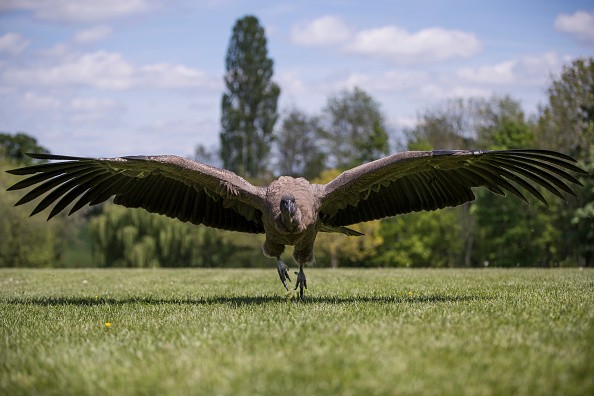Over a dozen of the sizable birds made themselves comfortable, destroying almost everything in sight.

Gymnogyps californianusi
Recently a semirural house in Southern California had some uncontrollable visitors: over a dozen condors. They were bad houseguests; they shredded a spa cover and screen door; they even destroyed lawn ornaments, potted plants, furniture; and got themselves relieved all over the deck. According to the Associated Press (AP), fifteen to twenty of the California condors (Gymnogyps californianusi) appeared at the house in Tehachapi, California, on the weekend of May 1.
The New York Times reported many of the birds assembled on the deck, and more still gathered on the roof. Some had numbered wing tags on, which the U.S. Fish and Wildlife Service's (FWS) California Condor Recovery Program uses to track and identify the birds, according to the website of the program.
The owner of the house, Cinda Mickols took pictures of the unwelcomed avian companions, and Seana Lyn Quintero - her daughter who is a graphic designer in San Francisco, posted the images on May 4 on Twitter. In the pictures, several condors alight on the deck railing and observed the wreckage of their commotion that lies all over the place across the deck, which was "completely trashed," Quintero wrote in the tweet.
Also Read: Wind Energy Company To Breed California Condors, Replace Those Killed by Turbines
Mickols' Photos
Even when not so many condors are seen in Mickols' photos, the deck appears crowded. That's due to the fact that California condors are sizable birds. Possessing a black-feathered body that's almost 1.3 meters (5 feet) long and a wingspan of around 3 m (9 feet), condors are the largest birds in North America, as stated by The Cornell Lab of Ornithology.
Their heads are usually pinkish, bald, and ringed by a luxurious feather ruff, and grown-ups have white feather patches beneath their wings and on their legs, The Cornell Lab discloses. These big birds are also greatly endangered. Just about 230 inhabit the wild in California, Baja and Arizona California, Mexico, and about 160 additional condors live in captivity, as stated by The Cornell Lab.

The Social Specie
But why did almost two dozen wild condors choose to take up short-term residence outside Mickols' home?
A supervisory wildlife biologist with the California Condor Recovery Program, Arianna Punzalan said: "The California condor is a social species, and large congregations of them are commonly seen within their habitat - like where this event took place."
Due to the fact that condors are scavengers (and, don't have a powerful sense of smell, unlike vulture), this social behavior assists them in locating decaying animal carcasses scattered across the landscape, Punzalan revealed to Live Science in an email. Over the past 25 years, populations of condor have been gradually rebuilding from historic lows in the 1980s, when there were only about 22 birds in the wild.
Related Article: Giant California Condors Trashes House in Tehachapi
For more news, updates about condors and similar topics don't forget to follow Nature World News!
© 2024 NatureWorldNews.com All rights reserved. Do not reproduce without permission.





